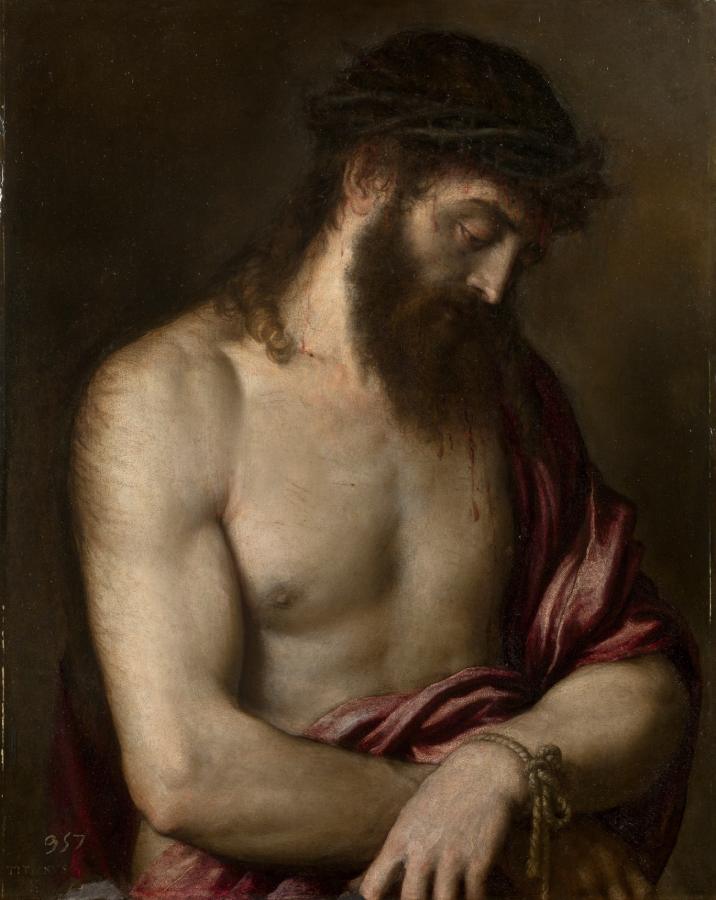Tiziano (c.1488-1576)
Ecce Homo
1547
Oil on slate, 69 x 56 cm
Museo del Prado, Madrid
Although we do not know when Titian first treated this subject, it was probably in 1535, when he painted a Christ for Federico Gonzaga following a model provided by the duke. The earliest surviving Ecce Homo is the one he did for Charles V and in which one detects his attempt to distance himself from the usual iconic impression of these images which are typically frontal and bust length. Instead, Titian shows Christ in three quarter length and at an angle. He combines the inherent drama of the subject, visible in the whip marks and the blood, with the serenity of someone who accepts his tragic destiny. This treatment of the Ecce Homo subject was extremely successful, either as a single figure or within a narrative context in the company of Pontius Pilate and showing Christ mocked by his torturers. In 1546 Titian gave Pope Paul III an Ecce Homo and another to Aretino in 1548 which was soon copied by Domenico Molino. We also know of a replica made that same year for Cardinal Granvelle of an Ecce Homo very similar to the Rome one. The devotional nature of these works has been emphasised in the literature, and they are often considered to be an example of how Titian adapted to Counter-Reformation requirements. The work clearly expressed an emotional pathos arousing the viewer’s empathy, as Pietro Aretino indicated in relation to his Ecce Homo, possibly the one now in the Musée Condé in Chantilly, which only differed from the present one in that Christ held a rod in his right hand. Having described the image, which he kept in his bedroom, as devout, Aretino adds: The suffering which Christ experiences would move to repentance anyone who looks with Christian compassion at his arms wounded by the rope which ties his hands: it would inspire to humility anyone who contemplates the pain caused by the rod which he holds in his right hand. This pietistic tone was the one sought by Charles V, which explains his satisfaction with the Ecce Homo which he took to Yuste, pairing it with a lost Virgin Dolorosa by Michiel Coxcie. In 1555 he commissioned a copy of it on slate by Jan Cornelisz. Vermeyen for the chapel in the Palace of Coudenbergh in Brussels. It is not known when Titian painted this Ecce Homo, but it was probably produced in Rome at the same time as the version painted for Paul III. Two circumstances make this likely: the monumental treatment of the anatomy, clearly inspired by Michelangelo, and the fact that it is the only painting by Titian on slate. While we know of Charles V‘s interest in this support, in Rome Titian must have come across Sebastiano’s use of slate for devotional paintings, and its success among members of the imperial court such as Francisco de los Cobos and the Count of Cifuentes. Philip II paired his Ecce Homo with the Virgin Dolorosa with her Hands Apart (P444) in his aposento (chamber) in the Alcazar in Madrid. It remained in that building until the fire of 1734 apart from a brief period in the Palace of El Pardo. That fire probably caused the abrasion apparent on the painting which is also evident, although to a lesser extent, on its pendant. The painting was later in the Palacio Real Nuevo, and then entered the Museo del Prado in 1821. (Falomir Faus, Miguel, Tiziano, Madrid, Museo Nacional del Prado, 2003, p.224)
